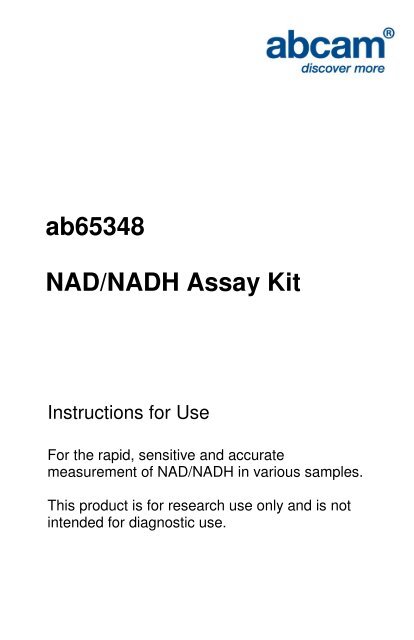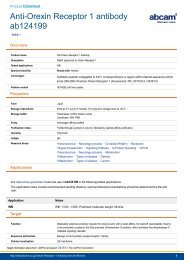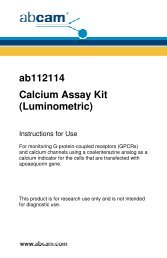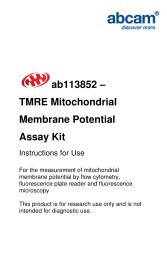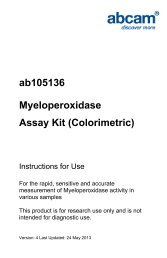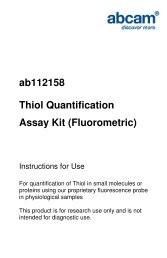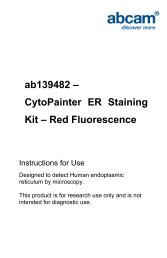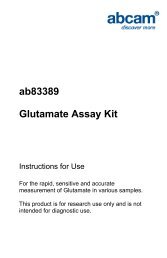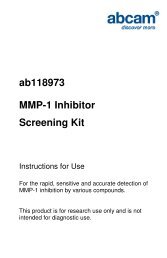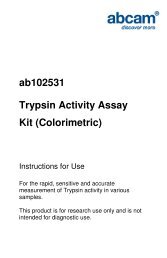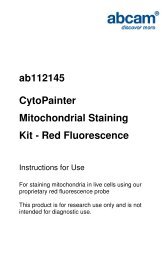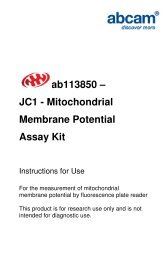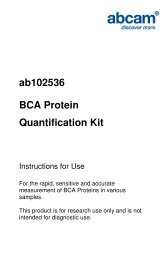ab65348 NAD/NADH Assay Kit - Abcam
ab65348 NAD/NADH Assay Kit - Abcam
ab65348 NAD/NADH Assay Kit - Abcam
Create successful ePaper yourself
Turn your PDF publications into a flip-book with our unique Google optimized e-Paper software.
<strong>ab65348</strong><br />
<strong>NAD</strong>/<strong>NAD</strong>H <strong>Assay</strong> <strong>Kit</strong><br />
Instructions for Use<br />
For the rapid, sensitive and accurate<br />
measurement of <strong>NAD</strong>/<strong>NAD</strong>H in various samples.<br />
This product is for research use only and is not<br />
intended for diagnostic use.
Table of Contents<br />
1. Overview 3<br />
2. Protocol Summary 4<br />
3. Components and Storage 5<br />
4. <strong>Assay</strong> Protocol 7<br />
5. Data Analysis 10<br />
6. Troubleshooting 11<br />
2
1. Overview<br />
<strong>Assay</strong> of nicotinamide nucleotides is of continual interest in the<br />
studies of energy transforming and redox state of cells or tissues.<br />
<strong>Abcam</strong>’s <strong>NAD</strong>H/<strong>NAD</strong> Quantification <strong>Kit</strong> provides a convenient tool for<br />
sensitive detection of the intracellular nucleotides: <strong>NAD</strong>H, <strong>NAD</strong> and<br />
their ratio. The <strong>NAD</strong> Cycling Enzyme Mix in the kit specifically<br />
recognizes <strong>NAD</strong>H/<strong>NAD</strong> in an enzyme cycling reaction. There is no<br />
requirement to purify <strong>NAD</strong>H/<strong>NAD</strong> from samples.<br />
The reaction specifically detects <strong>NAD</strong>H and <strong>NAD</strong>, but not <strong>NAD</strong>P nor<br />
<strong>NAD</strong>PH. The enzyme cycling reaction significantly increases the<br />
detection sensitivity and specificity. <strong>NAD</strong>t (<strong>NAD</strong> and <strong>NAD</strong>H) or<br />
<strong>NAD</strong>H can be easily quantified by comparing with standard <strong>NAD</strong>H.<br />
3
2. Protocol Summary<br />
Sample Preparation<br />
Standard Curve Preparation<br />
Prepare and Add Reaction Mix<br />
Measure Optical Density<br />
4
3. Components and Storage<br />
A. <strong>Kit</strong> Components<br />
Item<br />
Quantity<br />
<strong>NAD</strong>H/<strong>NAD</strong> Extraction Buffer<br />
50 mL<br />
<strong>NAD</strong> Cycling Buffer<br />
15 mL<br />
<strong>NAD</strong> Cycling Enzyme Mix<br />
1 vial<br />
<strong>NAD</strong>H Developer<br />
1 vial<br />
Stop Solution<br />
1.2mL<br />
<strong>NAD</strong>H Standard (MW:763) 152.6 µg<br />
Store kit at -20°C.<br />
The enzymes are stable for up to 2 months at -80°C after<br />
reconstitution.<br />
Ensure that the <strong>NAD</strong> Cycling Buffer is at room temperature before<br />
use. Keep other enzymes on ice during the assay and protect from<br />
light.<br />
5
B. Additional Materials Required<br />
• Microcentrifuge<br />
• Pipettes and pipette tips<br />
• Colorimetric microplate reader<br />
• 96 well plate<br />
• Orbital shaker<br />
6
4. <strong>Assay</strong> Protocol<br />
1. Sample Preparation:<br />
a) For cell samples: Wash cells with cold PBS. Pellet 2 X 10 5 cells<br />
for each assay in a micro-centrifuge tube (2000 rpm for 5 min).<br />
Extract the cells with 400 µl of <strong>NAD</strong>H/<strong>NAD</strong> Extraction Buffer by<br />
freeze/thaw two cycles (20 min on dry-ice, then 10 min at room<br />
temperature), or homogenization. Vortex the extraction for<br />
10 sec. Spin the sample at 14000 rpm for 5 min. Transfer the<br />
extracted <strong>NAD</strong>H/<strong>NAD</strong> supernatant into a labeled tube.<br />
b) For tissue samples (weight ~20 mg): Wash with cold PBS,<br />
homogenize with 400 µl of <strong>NAD</strong>H/<strong>NAD</strong> Extraction Buffer in a<br />
micro-centrifuge tube. Spin the sample at 14000 rpm for 5 min.<br />
Transfer the extracted <strong>NAD</strong>H/<strong>NAD</strong> supernatant into a new tube.<br />
Note:<br />
Cell or tissue lysates may contain enzymes that consume <strong>NAD</strong>H<br />
rapidly. We suggest removal of these enzymes by filtering the<br />
samples through 10 kDa molecular weight cut off filters (ab93349)<br />
before performing the assay.<br />
2. Standard Curve Preparation:<br />
Reconstitute <strong>NAD</strong>H standard with 200 µl of pure DMSO to generate<br />
1 nmol/µl <strong>NAD</strong>H standard solution. Dilute 10 µl of the 1 nmol/µl<br />
<strong>NAD</strong>H standard with 990 µl <strong>NAD</strong>H/<strong>NAD</strong> Extraction Buffer to<br />
7
generate 10 pmol/µl standard <strong>NAD</strong>H (Note: diluted <strong>NAD</strong>H solution is<br />
unstable, must be used within 4 hours).<br />
Add 0, 2, 4, 6, 8, 10 µl of the diluted <strong>NAD</strong>H standard into labeled<br />
96-well plate in duplicate to generate 0, 20, 40, 60, 80, 100 pmol/well<br />
standard. Make the final volume to 50 µl with <strong>NAD</strong>H/<strong>NAD</strong> extraction<br />
buffer.<br />
a. To detect total <strong>NAD</strong>t (<strong>NAD</strong>H and <strong>NAD</strong>): Transfer 50 µl of<br />
extracted samples into labeled 96-well plate in duplicates.<br />
We recommend performing several different sample dilutions with<br />
the Extraction Buffer to ensure the readings fall in the standard<br />
curve range.<br />
b. To detect <strong>NAD</strong>H: <strong>NAD</strong> needs to be decomposed before the<br />
reaction. To decompose <strong>NAD</strong>, aliquot 200 µl the extracted<br />
samples into eppendorf tubes. Heat to 60°C for 30 min in a water<br />
bath or a heating block. Under these conditions, all <strong>NAD</strong> will be<br />
decomposed, while <strong>NAD</strong>H will still be intact. Cool samples on ice.<br />
Quick spin the samples to remove precipitates if precipitation<br />
occurs.<br />
Transfer 50 µl of <strong>NAD</strong> decomposed samples into labeled 96-well<br />
plate in duplicates.<br />
We recommend performing several different sample dilutions with<br />
the Extraction Buffer to ensure the readings fall in the standard<br />
curve range.<br />
8
3. <strong>NAD</strong> Cycling Mix:<br />
a) Reconstitute <strong>NAD</strong> Cycling Enzyme Mix with 220 µl <strong>NAD</strong> Cycling<br />
Buffer. Reconstitute <strong>NAD</strong>H developer with 1.2 ml of ddH 2 O.<br />
Pipette up and down several times to completely dissolve the<br />
pellet into solution (don’t vertex). Aliquot enough <strong>NAD</strong> Cycling<br />
Enzyme mix (2 µl per assay) for the number of assays to be<br />
performed in each experiment and freeze the stock solution<br />
immediately at -80°C for future use. The enzymes are stable for<br />
up to 2 months at -80°C after reconstitution.<br />
b) Prepare a <strong>NAD</strong> Cycling Mix for each reaction:<br />
<strong>NAD</strong> Cycling Buffer: 100 µl<br />
<strong>NAD</strong> Cycling Enzyme Mix: 2 µl<br />
c) Mix well and add 100 µl of the mix into each well of <strong>NAD</strong>H<br />
standard and samples.<br />
4. Mix and incubate the plate at room temperature for 5 min to<br />
convert <strong>NAD</strong> to <strong>NAD</strong>H.<br />
5. Add 10 µl <strong>NAD</strong>H developer into each well. Let the reaction cycling<br />
at room temperature for 1 to 4 hours or longer depend on the<br />
reading of OD 450nm .<br />
6. Read the plate at OD 450nm . The plate can be read multiple times<br />
while the color is in developing. The reactions can be stopped by<br />
adding 10 µl of Stop Solution into each well and mix well. The color<br />
9
should be stable within 48 hours in a sealed plate after addition of<br />
Stop Solution.<br />
5. Data Analysis<br />
Apply the sample readings to <strong>NAD</strong>H standard curve. The amount of<br />
<strong>NAD</strong>t or <strong>NAD</strong>H in the sample wells can be calculated, then divide the<br />
<strong>NAD</strong>t or <strong>NAD</strong>H amount by the sample amount (e.g. cell number or<br />
extract protein amount) you added into the sample wells. The<br />
concentration of <strong>NAD</strong>t or <strong>NAD</strong>H can be expressed in pmol/10 6 cells<br />
or ng/mg protein (<strong>NAD</strong>H molecular weight 664.4).<br />
<strong>NAD</strong>/<strong>NAD</strong>H Ratio is calculated as:<br />
<strong>NAD</strong>t – <strong>NAD</strong>H<br />
<strong>NAD</strong>H<br />
10
6. Troubleshooting<br />
Problem Reason Solution<br />
<strong>Assay</strong> not<br />
working<br />
Unexpected<br />
results<br />
<strong>Assay</strong> buffer at<br />
wrong temperature<br />
Protocol step missed<br />
Plate read at<br />
incorrect wavelength<br />
Unsuitable microtiter<br />
plate for assay<br />
Measured at wrong<br />
wavelength<br />
Samples contain<br />
impeding substances<br />
Unsuitable sample<br />
type<br />
Sample readings are<br />
outside linear range<br />
<strong>Assay</strong> buffer must not be chilled<br />
- needs to be at RT<br />
Re-read and follow the protocol<br />
exactly<br />
Ensure you are using<br />
appropriate reader and filter<br />
settings (refer to datasheet)<br />
Fluorescence: Black plates<br />
(clear bottoms);<br />
Luminescence: White plates;<br />
Colorimetry: Clear plates.<br />
If critical, datasheet will indicate<br />
whether to use flat- or U-shaped<br />
wells<br />
Use appropriate reader and filter<br />
settings described in datasheet<br />
Troubleshoot and also consider<br />
deproteinizing samples<br />
Use recommended samples<br />
types as listed on the datasheet<br />
Concentrate/ dilute samples to<br />
be in linear range<br />
11
Samples<br />
with<br />
inconsistent<br />
readings<br />
Lower/<br />
Higher<br />
readings in<br />
samples<br />
and<br />
standards<br />
Unsuitable sample<br />
type<br />
Samples prepared in<br />
the wrong buffer<br />
Samples not<br />
deproteinized (if<br />
indicated on<br />
datasheet)<br />
Cell/ tissue samples<br />
not sufficiently<br />
homogenized<br />
Too many freezethaw<br />
cycles<br />
Samples contain<br />
impeding substances<br />
Samples are too old<br />
or incorrectly stored<br />
Not fully thawed kit<br />
components<br />
Out-of-date kit or<br />
incorrectly stored<br />
reagents<br />
Reagents sitting for<br />
extended periods on<br />
ice<br />
Incorrect incubation<br />
time/ temperature<br />
Incorrect amounts<br />
used<br />
Refer to datasheet for details<br />
about incompatible samples<br />
Use the assay buffer provided<br />
(or refer to datasheet for<br />
instructions)<br />
Use the 10kDa spin column<br />
(ab93349)<br />
Increase sonication time/<br />
number of strokes with the<br />
Dounce homogenizer<br />
Aliquot samples to reduce the<br />
number of freeze-thaw cycles<br />
Troubleshoot and also consider<br />
deproteinizing samples<br />
Use freshly made samples and<br />
store at recommended<br />
temperature until use<br />
Wait for components to thaw<br />
completely and gently mix prior<br />
use<br />
Always check expiry date and<br />
store kit components as<br />
recommended on the datasheet<br />
Try to prepare a fresh reaction<br />
mix prior to each use<br />
Refer to datasheet for<br />
recommended incubation time<br />
and/ or temperature<br />
Check pipette is calibrated<br />
correctly (always use smallest<br />
volume pipette that can pipette<br />
entire volume)<br />
12
Problem Reason Solution<br />
Standard<br />
curve is not<br />
linear<br />
Not fully thawed kit<br />
components<br />
Pipetting errors when<br />
setting up the<br />
standard curve<br />
Incorrect pipetting<br />
when preparing the<br />
reaction mix<br />
Air bubbles in wells<br />
Concentration of<br />
standard stock<br />
incorrect<br />
Errors in standard<br />
curve calculations<br />
Use of other<br />
reagents than those<br />
provided with the kit<br />
Wait for components to thaw<br />
completely and gently mix prior<br />
use<br />
Try not to pipette too small<br />
volumes<br />
Always prepare a master mix<br />
Air bubbles will interfere with<br />
readings; try to avoid producing<br />
air bubbles and always remove<br />
bubbles prior to reading plates<br />
Recheck datasheet for<br />
recommended concentrations of<br />
standard stocks<br />
Refer to datasheet and re-check<br />
the calculations<br />
Use fresh components from the<br />
same kit<br />
For further technical questions please do not hesitate to<br />
contact us by email (technical@abcam.com) or phone (select<br />
“contact us” on www.abcam.com for the phone number for<br />
your region).<br />
13
UK, EU and ROW<br />
Email: technical@abcam.com<br />
Tel: +44 (0)1223 696000<br />
www.abcam.com<br />
US, Canada and Latin America<br />
Email: us.technical@abcam.com<br />
Tel: 888-77-ABCAM (22226)<br />
www.abcam.com<br />
China and Asia Pacific<br />
Email: hk.technical@abcam.com<br />
Tel: 108008523689 ( 中 國 聯 通 )<br />
www.abcam.cn<br />
Japan<br />
Email: technical@abcam.co.jp<br />
Tel: +81-(0)3-6231-0940<br />
www.abcam.co.jp<br />
15<br />
Copyright © 2012 <strong>Abcam</strong>, All Rights Reserved. The <strong>Abcam</strong> logo is a registered trademark.<br />
All information / detail is correct at time of going to print.


